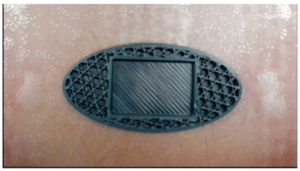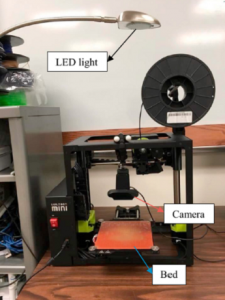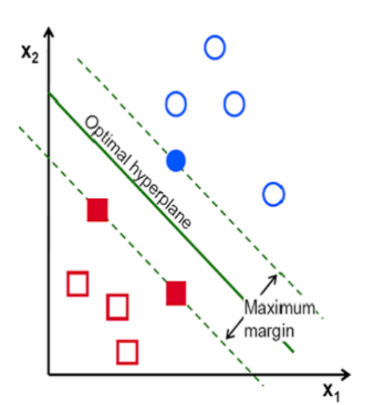 All sorts of issues can occur when a 3D printed part has a defect, and researchers around the world continue trying to find new ways to detect these defects before they cause too many problems. Now, two researchers from the Department of Industrial and Manufacturing Systems Engineering (IMSE) at Kansas State University are taking on the challenge as well.
All sorts of issues can occur when a 3D printed part has a defect, and researchers around the world continue trying to find new ways to detect these defects before they cause too many problems. Now, two researchers from the Department of Industrial and Manufacturing Systems Engineering (IMSE) at Kansas State University are taking on the challenge as well.
Not all 3D printers have a designated system for tracking and monitoring 3D printing progress during the job, which means that some parts will continue to print even if there are defects. Ugandhar Delli and Dr. Shing Chang from IMSE have proposed a new method to monitor the 3D printing process by pausing the system at different checkpoints, in order to take stock of things and find any defects; then, corrective actions, such as stopping the print if defects are detected, can be taken if necessary.
Production-scale 3D printing operations especially need automatic process monitoring, as finding defects and halting the prints during the critical stages of the process can not only save money but also cut back on material waste.
Delli and Dr. Chang published a paper on their research, titled “Automated Process Monitoring in 3D Printing Using Supervised Machine Learning,” that details their new process monitoring method in the Procedia Manufacturing journal.
The abstract reads, “Quality monitoring is still a big challenge in additive manufacturing, popularly known as 3D printing. Detection of defects during the printing process will help eliminate waste of material and time. Defect detection during the initial stages of printing may generate an alert to either pause or stop the printing process so that corrective measures can be taken to prevent the need to reprint the parts. This paper proposes a method to automatically assess the quality of 3D printed parts with the integration of a camera, image processing, and supervised machine learning. Images of semi-finished parts are taken at several critical stages of the printing process according to the part geometry. A machine learning method, support vector machine (SVM), is proposed to classify the parts into either ‘good’ or ‘defective’ category. Parts using ABS and PLA materials were printed to demonstrate the proposed framework. A numerical example is provided to demonstrate how the proposed method works.”
The researchers used a LulzBot Mini 3D printer for their research, which involved checking on the part during the 3D printing process at multiple checkpoints; these are defined as critical stages where there is a major change to a part’s geometry.
Delli and Dr. Chang wrote in the paper, “For example, consider a complex part which involves different stages of printing like skirt/base, body and the top. These stages could be considered as the desired checkpoints to inspect quality at.”
Their method used an integrated camera, image processing, and a supervised machine learning model, called a support vector machine (SVM), to automatically assess part quality. The researchers defined three steps in order to implement their proposed 3D printing quality monitoring during production:
- Identify the proper checkpoints for the 3D printed part according to its geometry.
- Take images of the semi-finished part at each checkpoint.
- Perform image processing and analysis.
The researchers concluded that their method could detect both structural or geometrical defects and completion failure detects. However, it’s not 100% foolproof just yet.
The main drawback of the proposed method is that the printing process needs to be paused while the images of a semi-finished part are taken,” Delli and Dr. Chang wrote. “Another drawback is that since only top view images are taken, the proposed method might not be able to detect the defects on the vertical plane which cannot be seen in the top view image. This gives us a direction for future research to incorporate cameras on the sides of the printer as well to detect defects on both the horizontal and vertical planes.”
Delli and Dr. Chang believe they could improve the method by in situ camera mounting on the print head. In the future, they will also work on studying the impacting factors for selecting the appropriate print checkpoints.
Discuss this story and other 3D printing topics at 3DPrintBoard.com or share your thoughts below.
Subscribe to Our Email Newsletter
Stay up-to-date on all the latest news from the 3D printing industry and receive information and offers from third party vendors.
Print Services
Upload your 3D Models and get them printed quickly and efficiently.
You May Also Like
Havaianas Collaborates with Zellerfeld to Launch 3D Printed Flip-Flops
The shoe of the summer is undoubtedly the flip-flop. Easy on, easy off, your feet won’t get sweaty because there’s not much material, and they’re available in a veritable rainbow...
UCLA Researchers Develop 3D Printed Pen that May Help Detect Parkinson’s Disease
Diagnosing Parkinson’s disease is difficult. Often, early symptoms of the progressive neurological condition may be overlooked, or mistaken for signs of aging. Early diagnosis can help save lives and improve...
Printing Money Episode 30: Q1 2025 Public 3D Printing Earnings Review with Troy Jensen, Cantor Fitzgerald
Printing Money is back with Episode 30, and it’s that quarterly time, so we are happy and thankful to welcome back Troy Jensen (Managing Director, Cantor Fitzgerald) to review the...
Heating Up: 3D Systems’ Scott Green Discusses 3D Printing’s Potential in the Data Center Industry
The relentless rise of NVIDIA, the steadily increasing pledges of major private and public investments in national infrastructure projects around the world, and the general cultural obsession with AI have...



































